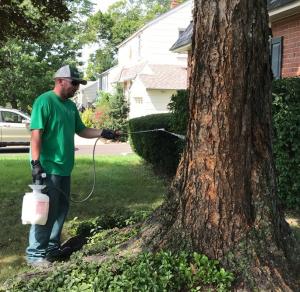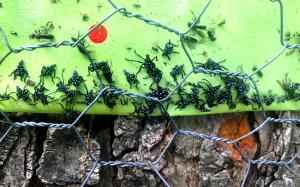
Giroud Plant Healthcare Manager, Rodney Stahl, Jr, performing a basal trunk spray to kill Spotted Lanternfly.
Giroud Tree and Lawn shares effective methods for killing Spotted Lanternfly nymphs and adults.
HUNTINGDON VALLEY, PA, UNITED STATES, July 6, 2021 /EINPresswire.com/ -- Many homeowners are frustrated with Spotted Lanternfly (SLF) and want to know how to kill these pesky insects. This invasive insect continues to multiply year after year. There are a variety of effective methods for killing SLF, and some are better than others.Using a Spotted Lanternfly Trap
Trapping can be an effective way to kill Spotted Lanternfly. These methods are most successful when the insect is in the nymph stage of its life cycle. Nymphs have not developed their wings yet, so they climb up trees to look for food. With the right trap in place, homeowners can catch them as they walk up the tree trunk.
However, nymphs are tricky. They quickly move from plant to plant and usually don?t linger for very long. The experts at Penn State have experimented with many types of traps. When it comes to trapping methods, they explain that ?You may catch a lot of SLF with a trap, but because they move around in the landscape, trapping will not prevent more SLF from coming to that tree.?
There are two popular Spotted Lanternfly traps; Sticky bands and circle traps.
Tree Banding
Banding trees in sticky tape can be a very effective way to capture and kill Spotted Lanternfly, especially SLF Nymphs. Sticky bands can be found at most hardware stores and online. They are easy to install, but they should be changed weekly.
Avoid Bycatch
Sticky bands can accidentally trap small animals and birds. To avoid this problem, Penn State recommends cutting the sticky bands lengthwise so the surface area is not as broad. Then, wrap the outside of the tree with chicken wire over the area of the sticky band. This will prevent squirrels, birds, and other small animals from becoming stuck to the band.
Circle Traps
Circle Traps are another good method for catching SLF Nymphs. They were originally designed to catch another tree insect called Pecan Weevils and can be purchased online. However, since Spotted Lanternfly invaded the U.S., many organizations and homeowners have shared DIY versions. Penn State offers directions on their website for how to build a circle trap here.
DIY Spray Methods
There are many ?Do It Yourself? spray methods for killing Spotted Lanternfly.
Killing SLF with Neem Oil and Insecticidal Soap
If homeowners see clusters of lantern flies attacking a specific plant, use a quick knockdown product like Neem Oil or insecticidal soap. Spray the oil or soap directly on the Nymphs to kill them on contact. It?s important to note, spot treatments will not have a long-term impact on the larger SLF population.
Homemade Spotted Lanternfly Spray
Some homeowners are preparing homemade sprays to kill SLF. There are a few recipes that work well, and they usually contain dish soap and vinegar. However, homeowners need to be careful using these sprays because they can also kill important plants and grass.
Professional Spotted Lanternfly Treatment
The most effective way to kill large quantities of Spotted Lanternfly is with professional treatments. Homeowners should find an ISA Certified Arborist to treat the property.
Giroud Tree and Lawn has been working closely with Penn State, the PA Department of Agriculture and the USDA to develop a successful SLF Control Program with a 3-step approach:
Foliar Nymph Spray (May-July)
This is recommended only in situations where there is a high spotted lanternfly infestation attacking a specific plant or tree. Beta-Cyfluthrin is sprayed on trunks, limbs, and foliage. The treatment will kill the Nymphs on contact and when they crawl on treated surfaces for up to 30 days.
Basal Trunk Spray (July-September)
Dinotefuran is sprayed around the trunk of the tree. It kills SLF both on-contact and systemically. For a few weeks after treatment, SLF are killed on contact or when they crawl on treated surfaces. After the insecticide is absorbed through the tree?s vascular system, SLF are killed when they feed on the tree. Treatment remains in the tree for up to 60 days.
Foliar Spray (September-November)
Bifenthrin is sprayed around the top canopy of the tree. This treatment kills the adult SLF on contact as they climb higher into the tree?s branches and walk over surfaces with the residue on it.
If homeowners see signs of Spotted Lanternfly on the property, they should schedule an inspection with an ISA Certified Arborist as soon as possible.
About Giroud Tree and Lawn
Giroud Tree and Lawn specializes in tree service, lawn care, and mosquito and tick control programs that make customers love doing business with the company since 1974. Serving Bucks, Montgomery, and Philadelphia Counties, the company offers professional tree and lawn evaluation, tree pruning, tree removal, insect and disease control, fertilizing, stump removal, traditional and 100% organic lawn programs, and mosquito and tick control. Giroud Arborists are certified by the International Society of Arboriculture (ISA) and have the knowledge and experience required to properly diagnose, treat and maintain trees and lawn health. The company is Accredited by the Tree Care Industry Association and Better Business Bureau. The ?Giroud Treework for Charity? program donates free tree care services to parks, historical sites, and other non-profit organizations located in the Company?s service area. For more information, visit the company website at http://www.giroudtree.com or call 215-682-7704.
Jeanne Hafner
Giroud Tree & Lawn
+1 2156827704
email us here
Visit us on social media:
Facebook
Twitter



